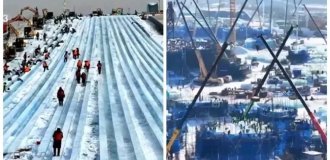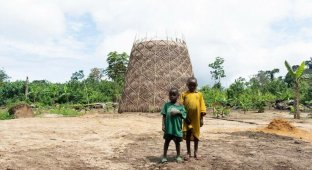Ancient sources of life in the desert. Qanats (5 photos)
Water is the basis of life on Earth. This statement is difficult to dispute, because water is needed by everyone - from plants and animals to the entire human civilization. Fresh water is especially important in deserts - no matter whether sandy or consisting of salt water. A person can survive without food for several days or even weeks, but without liquid he will die very quickly. Ancestors understood this very well, so wells and sources of clean water have always been considered a strategic object. 
Kariz tunnel from the inside
So, endless deserts, in which there are only sand dunes stretching beyond the horizon, or rocky ground, where almost nothing grows. And it is there that buildings are located, which are sometimes many hundreds of years old. We will talk about the miracle of hydraulic engineering, giving life to everyone in this hospitable place - kariz.
Moisture is present everywhere on the planet, but not always in a form that can be consumed immediately. In the deserts and plateaus of modern Iran, Afghanistan and all of Central Asia, people have long known how to extract water from underground aquifers. However, the name of the inventor of the kariz is lost in the mists of time. It is quite possible that this system was invented by a whole group of people.
In essence, a kariz is perhaps one of the most ancient hydraulic engineering systems known to mankind. It is an underground channel, usually in the form of a clay horizontal adit, connecting the aquifer with the surface. The water extracted from it is used both for drinking and for everyday needs such as watering plants. The tunnels themselves are usually large enough for an adult to easily walk through. This is done to ensure the constant operability of the kariz and to clean it from dirt, silt and sand. 
A kariz near Erfoud in Morocco. The entire hydraulic system is located underground
The kariz adit is usually located at a slight slope so that the water flow rate is minimal and does not deplete the underground sources. The low temperature in the kariz allows local residents to use them for cooling and long-term storage of food. In places where the water flow is strong enough, water mills were often built.. Entire pools for storing water during the dry season were also located underground. It was the kariz located near the aquifers that became the site of the formation of many ancient settlements.
The largest and oldest known karez today is located in the Iranian city of Gonabad and is listed by UNESCO as a World Heritage Site. According to experts, it was built about 2,700 years ago. To this day, the karez is actively used, providing water to about 40,000 people.
Scientists believe that many ancient settlements and cities built around karez formed their unique architecture and social structure thanks to them. The fact is that the cooler water was immediately at the mouth of the karez, and the closer the townspeople lived to the water source, the more privileged they were considered.
The importance of these structures is evidenced by the fact that, for example, Iran is 4/5 dependent on water extracted from them. Interestingly, a similar technology is mentioned in ancient Chinese texts. Thus, the irrigation system located in the Turpan Depression was the most important component first for the development of the region, and then a point through which the Great Silk Road passed. The karizes in the territory of Turpan have a length of about 2500 kilometers. 
Inside the Turpan Water System
The 15th century karizes are located right on the territory of the Shirvanshahs' Palace complex in Baku, which also confirms the theory that the wealthiest people in this region could afford clean and cool water, while the rest were content with what was left.
The antiquity of many kariz is due to the fact that no matter what people came to Central Asia, everyone needed water. Therefore, rulers and states changed, but the structures built hundreds, if not thousands of years ago, still exist. Even now, the profession of "mukanni" - builders of kariz - is respected and revered among local people. Knowledge of the design and construction of kariz was passed down from century to century in the families of mukanni.
Usually 3-5 people work on each kariz, and its construction is extremely lengthy. A mukanni must be able to not only dig a tunnel, but also find the right place for construction. This is hard work, and it progresses at a speed of 3-4 meters per day by the same 3-5 people. However, an already created kariz, as practice shows, will last a very, very long time. 
Photo from the museum in Turpan, dedicated to karez. In the photo is a sculpture of a man working on the creation of a karez
Their widespread use has only begun to be abandoned in recent years, with preference given to modern water wells. Unlike ancient technologies, wells do not require constant maintenance. On the other hand, karez do not depend on electricity. In Asian countries, despite the advent of new technologies, people continue to use ancient water sources.
In conclusion, it is worth saying that, despite the rather disdainful attitude of modern people towards the technologies of the past, they are by no means as primitive as they may seem. The creation of karez often took years, and all this required serious knowledge in engineering and geology. But as a result, these structures provided life for centuries in the lands where they were built.






























